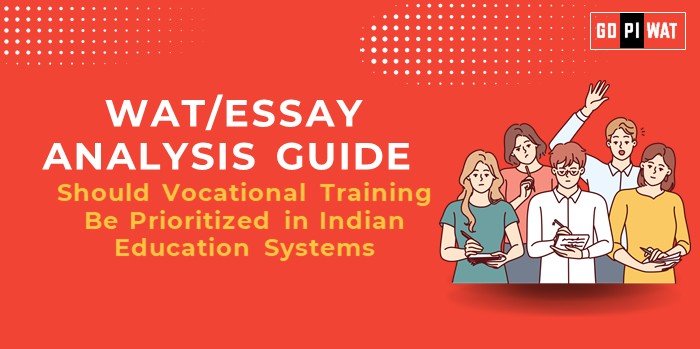📋 Should Vocational Training Be Prioritized in Indian Education Systems?
🌐 WAT/Essay Analysis Guide
💡 Understanding the Topic’s Importance
Vocational training is pivotal for leveraging India’s demographic dividend, reducing unemployment, and enhancing productivity. It aligns with NEP 2020, which emphasizes skill-based education as a driver of economic growth and employability.
⏳ Effective Planning and Writing
- 🕒 Time Allocation:
- 📝 Planning: 5 minutes
- ✍️ Writing: 20 minutes
- 🔍 Reviewing: 5 minutes
- 📋 Preparation Tips:
- 📊 Highlight statistics such as skill gap projections and youth unemployment.
- 🌍 Note global benchmarks like Germany’s dual vocational system and regional successes like Kerala’s integration of vocational training.
💬 Introduction Techniques
- ⚖️ Contrast Approach: “While India’s education system produces millions of graduates annually, only 4.7% are vocationally trained, a stark contrast to developed economies.”
- 🔧 Solution-Based Approach: “Vocational training is the bridge between education and employability in a country with 10.6% youth unemployment.”
📊 Structuring the Essay Body
🏆 Achievements:
- 📜 NEP 2020: Promotes vocational training from Grade 6 onward to align education with industry demands.
- 🚀 Skill Development Programs: Initiatives like Pradhan Mantri Kaushal Vikas Yojana (PMKVY) aim to upskill India’s youth.
- 🌟 Regional Success: Kerala successfully integrates vocational education into schools, enhancing employability.
⚠️ Challenges:
- 🔻 Societal Stigma: Vocational education is often viewed as inferior to mainstream academic education.
- 🏫 Infrastructure Gaps: Lack of modern tools, trained educators, and funding limit effective implementation.
- 🌍 Urban-Rural Divide: Limited vocational opportunities in rural areas restrict access for underserved communities.
🚀 Future Outlook:
- 💻 Technology Integration: Leverage digital tools like AI and virtual simulations to modernize vocational training.
- 🤝 Global Partnerships: Collaborate with industries and international models to replicate successful systems like Germany’s dual vocational model.
- 🌟 Mindset Shift: Launch awareness campaigns to promote vocational training as a valuable career pathway.
✅ Concluding Effectively
- ⚖️ Balanced Perspective: “Vocational training enhances employability and economic growth but requires robust infrastructure and societal acceptance to thrive.”
- 🌍 Global Comparison: “India can emulate Germany’s dual system to establish vocational training as a cornerstone of education, fostering sustainable growth and global competitiveness.”
📊 Analyzing Successes and Shortcomings
- ✨ Key Achievements:
- 🎓 Integration of skill training through NEP 2020.
- 🚀 Increased female participation in vocational programs.
- ⚠️ Ongoing Challenges:
- 📉 Limited outreach to rural areas.
- 🏫 Shortage of quality infrastructure and trained teachers.
- 🌍 Global Context:
- 🇩🇪 Germany: Dual vocational system integrates classroom learning with practical work experience.
- 🇰🇷 South Korea: Strong emphasis on technical education has led to a highly skilled workforce.
💡 Recommendations for Sustainable Progress
- 🤝 Strengthen Industry Partnerships: Collaborate with industries to design curricula aligned with market needs.
- 💻 Promote Technology: Use digital tools and AI-driven platforms to modernize vocational training.
- 🎓 Combat Stigma: Launch awareness campaigns to highlight vocational education as a valuable career choice.
📝 Sample Short Essays
🔹 Balanced Perspective:
“Vocational training is essential for bridging India’s skill gap. While PMKVY and NEP 2020 lay the foundation, societal stigma and infrastructure challenges must be addressed to realize its full potential.”
🔹 Solution-Oriented:
“Integrating vocational training from grade 6, as suggested in NEP 2020, can transform education into a practical, job-ready framework. Industry partnerships and modern technology will be key to successful implementation.”
🔹 Global Comparison:
“Adopting Germany’s dual system model can make vocational training a cornerstone of Indian education, fostering employability and sustainable economic growth while addressing unemployment challenges.”


